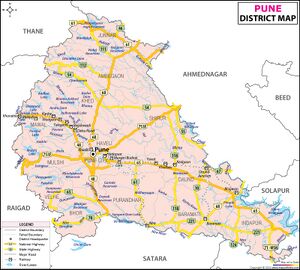Karle

Karle Caves or Karla Caves or or Karla Cells are a complex of ancient Indian Buddhist rock-cut cave shrines located in Karli near Lonavala, in Pune district in Maharashtra.
Variations
- Karli (कार्ली) (महा.) (AS, p.175)
- Viharaganva/Vihara-ganva (विहारगांव) (AS, p.866)
- Karle Caves
- Karla Caves
- Karla
Location
Karli (also Karla) town is on the highway between Pune and Mumbai in southern Maharashtra. Karli's location in Maharashtra places it in a region that marks the division between North India and South India.
Period
The shrines were developed over the period – from the 2nd century BC to the 5th century AD. The oldest of the cave shrines is believed to date back to 160 BC, having arisen near a major ancient trade route, running eastward from the Arabian Sea into the Deccan.
History
The caves are believed to be some of thousands of similar caves excavated in the Sahyadri Hills in the early 1st millennium AD.
The caves were historically associated with the Mahāsāṃghika sect of Buddhism and later with Hinduism, which had great popularity in this region of India, as well as wealthy patronage.[1][2] The caves house a Buddhist monastery dating back to the 2nd century BC. The monastery was once home to two 15-meter grand pillars. Now only one of these remains, and the remaining space is occupied by a temple dedicated to the goddess Ekveera, who is worshipped most notably by the Koli community of Mumbai.
कार्ली (महाराष्ट्र)
विजयेन्द्र कुमार माथुर[3] ने लेख किया है ...कार्ली (महाराष्ट्र) (AS, p.175) पुणे के समीप लानवी स्टेशन से 6 मील दूर है. यहां पहाड़ में कटी हुई गुफा के भीतर शती ईसा पूर्व में बनी हुई भारत प्रसिद्ध बौद्ध चैत्यशाला स्थित है जो बौद्ध चैत्यों में सर्वाधिक विशाल तथा भव्य हैं. फर्ग्युसन के मत में चैत्य-निर्माण-कला की दृष्टि से कार्ली का चैत्य सभी चैत्यो से अधिक सुंदर है. गुफा के बाहर एक सुंदर प्रस्तर स्तंभ है. इस गुफा में कई अभिले अंकित हैं जिन से ज्ञात होता है कि दूसरी सदी ईसा पूर्व के लगभग वशवदत्त ने इस गुहा मंदिर को बनवाया था तथा अजामित्र ने गुफा के बाहर के स्तंभ की स्थापना की थी. यह गुफा महाराष्ट्र में आंध्र नरेशों के शासनकाल में बनी थी. चैत्य के पार्श्व में कई छोटे-छोटे बिहार भी हैं. चैत्य के बाहर उन राजाओं तथा रानियों की मूर्तियां भी निर्मित हैं जिनके समय में यह बना था. कार्ली का एक प्राचीन नाम विहार-गांव भी है.
विहार-गांव
विजयेन्द्र कुमार माथुर[4] ने लेख किया है ...विहार-गांव (p.866) - कार्ली का एक प्राचीन नाम विहार-गांव भी है. यह नाम यहाँ स्थित बौद्ध-विहार तथा चैत्य के कारण ही हुआ था.
कार्ले गुफ़ाएँ
कार्ले चैत्यगृह अथवा 'कार्ले गुफ़ाएँ' अथवा 'कार्ला गुफ़ाएँ' 2 शताब्दी ईसा पूर्व से 2 शताब्दी ईस्वी और 5 वीं शताब्दी से 10 वीं सदी के बीच दो बार में विकसित प्राचीन ग़ुफ़ाएँ हैं जो महाराष्ट्र राज्य के पुणे और मुम्बई के मध्य एक नगर 'कार्ला' में स्थित हैं। चैत्यगृह की लम्बाई 38.25 मीटर, चौड़ाई 15.10 मीटर तथा ऊँचाई 14.50 मीटर है। यह चैत्यगृह दोनों तरफ़ सीधी रेखा में बने स्तम्भों के लिए प्रसिद्ध है। इस विशाल चैत्यगृह में तीन विहार भी हैं। इसमें आगे का भाग दो मंजिला है, और नीचे के हिस्से में तीन दरवाज़े हैं। ऊपर एक बरामदा है, जिसमें एक विशाल चैत्य गवाक्ष है। चैत्यगृह के अन्दर एवं बाहर कई अभिलेख अंकित है। इसी आधार पर इसके निर्माण का समय प्रथम शताब्दी ई. का प्रारम्भिक चरण माना जाता है।
संदर्भ: कार्ले चैत्यगृह
References
- ↑ Dutt, Nalinaksha. Buddhist Sects in India. 1998. p. 62
- ↑ Gadkari, Jayant. Society and Religion: From Rgveda to Puranas. 1996. p. 198
- ↑ Aitihasik Sthanavali by Vijayendra Kumar Mathur, p.175
- ↑ Aitihasik Sthanavali by Vijayendra Kumar Mathur, p.866

